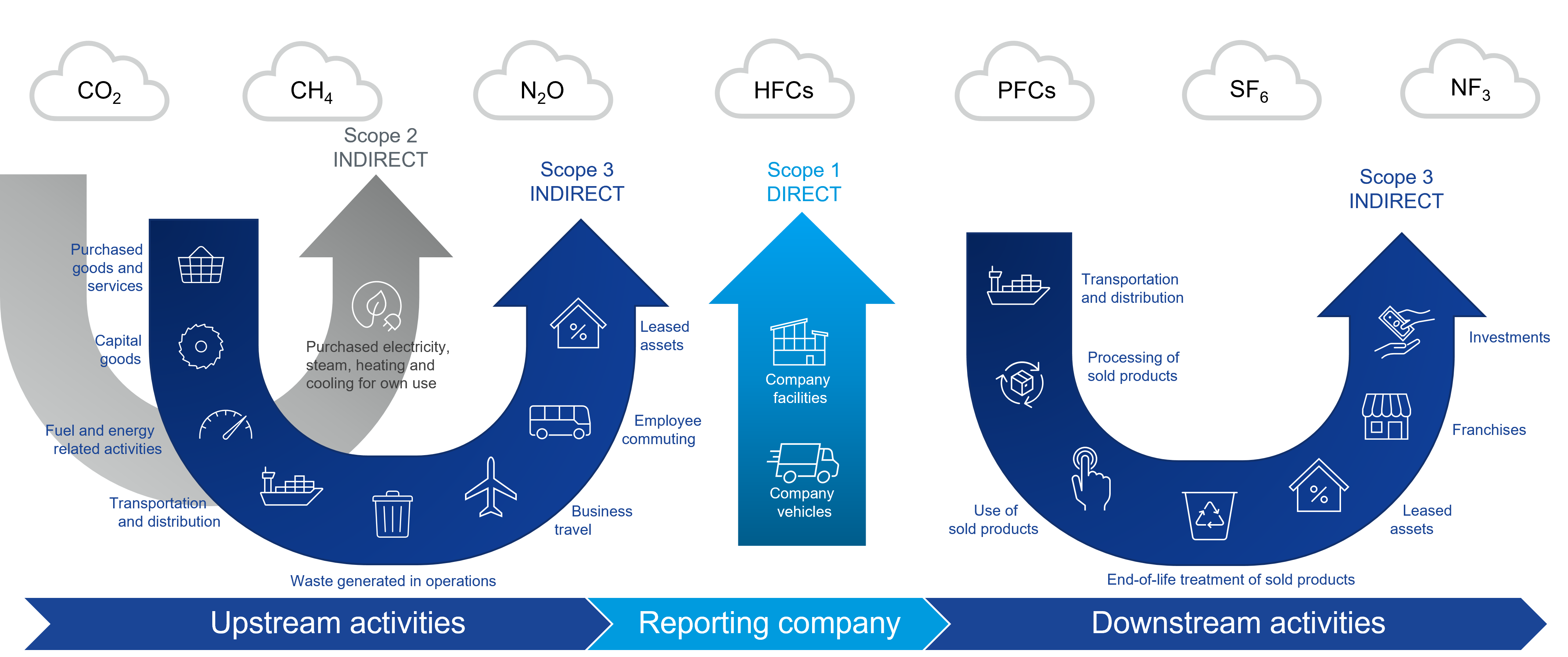Defining Decarbonization and Net Zero
Decarbonization is the strategic process of reducing carbon emissions across all aspects of business operations and supply chains. For industries, this involves implementing practices and technologies that minimize reliance on fossil fuels and lower greenhouse gas (GHG) emissions across all scopes. A structured approach to decarbonization aligns organizations with global climate goals while enhancing long-term sustainability and regulatory compliance.
Understanding Greenhouse Gas (GHG) Emissions Scopes
GHG emissions are categorized into three distinct scopes, each representing different sources of emissions within an organization’s operations and value chain.
Scope 1: Direct Emissions
Scope 1 emissions originate from sources owned or controlled by an organization and result from direct combustion or industrial processes. These include:
Stationary Combustion: Emissions from burning fossil fuels in equipment such as boilers, furnaces, or turbines.
Mobile Combustion: Emissions from company-owned vehicles, including fleet trucks, delivery vehicles, or service cars.
Process Emissions: GHG emissions from industrial processes, such as chemical reactions in cement, steel, or chemical manufacturing.
Fugitive Emissions: Unintentional leaks from refrigeration and air conditioning systems or natural gas pipelines.
Scope 2: Indirect Emissions from Purchased Energy
Scope 2 emissions are indirect emissions resulting from the consumption of purchased energy, such as electricity, steam, heating, or cooling. These emissions occur at the source of energy generation but are attributed to the organization’s energy consumption. Key contributors include:
Scope 3: Other Indirect Emissions
Scope 3 emissions encompass all other indirect emissions that occur within an organization’s value chain but fall outside its direct operational control. These emissions are further categorized into upstream and downstream activities:
Upstream Activities:
Emissions from the procurement of goods and services.
Transportation and distribution of raw materials.
Employee commuting and business travel.
Waste management and disposal.
Downstream Activities:
Emissions from the use of sold products (e.g., fuel combustion in customer-owned vehicles).
End-of-life treatment of products (e.g., recycling, landfill disposal).
Transportation and distribution of finished goods.
The Strategic Importance of Decarbonization
A structured decarbonization strategy is essential for mitigating climate risks, aligning with regulatory frameworks, and achieving corporate sustainability objectives. By reducing emissions across all scopes, organizations can enhance operational efficiency, improve stakeholder trust, and contribute to a cleaner, more resilient economy.
Figure 01
A representation of Scopes 1,2 & 3

Source: Ark Energy IC
Achieving Net Zero: A Strategic Approach
Achieving Net Zero entails balancing carbon emissions with an equivalent amount of carbon removal, ensuring no net increase in atmospheric greenhouse gases. This objective is fundamental to global climate commitments, such as the Paris Agreement, and is increasingly recognized as a critical benchmark for corporate environmental responsibility.
For organizations, the transition to Net Zero is a complex yet essential journey that requires a structured approach, encompassing a clear understanding of emissions sources, the establishment of actionable targets, and the deployment of effective decarbonization strategies. Breaking down this complexity into practical, measurable steps enables businesses to navigate the transition with clarity and purpose.
Developing an Effective Net Zero Strategy
A robust Net Zero strategy begins with a comprehensive emissions inventory, identifying major sources of greenhouse gas (GHG) emissions across operations, supply chains, and product life cycles. This Baseline Assessment involves:
Conducting energy audits to assess consumption patterns and identify inefficiencies.
Mapping emissions across Scope 1 (direct), Scope 2 (indirect from purchased energy), and Scope 3 (indirect from the value chain) to quantify their impact.
Leveraging advanced analytical tools, such as life-cycle assessments (LCA) and digital twin modeling, to simulate and optimize decarbonization initiatives.
Establishing Goals and Milestones
To ensure measurable progress and accountability, organizations must set time-bound Net Zero targets that align with global frameworks such as the Science Based Targets initiative (SBTi). These targets typically include:
Short-term goals: Implementing energy efficiency measures and integrating low-carbon procurement practices.
Medium-term goals: Transitioning core operations to renewable energy sources and adopting sustainable supply chain practices.
Long-term goals: Achieving full decarbonization through advanced carbon capture, removal solutions, and circular economy initiatives.
Stakeholder Engagement and Collaboration
Like any transformative business strategy, achieving Net Zero requires broad organizational and external alignment. Key stakeholders include:
Internal stakeholders: Employees and leadership teams must be engaged, educated, and incentivized to drive sustainability initiatives.
External stakeholders: Suppliers, customers, and industry partners play a crucial role in fostering sustainable value chains and shared commitments.
Policymakers and communities: Proactive engagement with regulatory bodies ensures compliance with evolving climate policies while fostering long-term partnerships for sustainable development.
By taking a structured and strategic approach, organizations can successfully navigate the complexities of decarbonization while positioning themselves as leaders in sustainability and corporate responsibility.